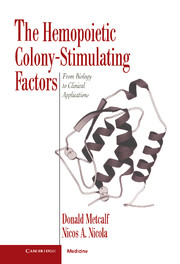Book contents
- Frontmatter
- Contents
- Preface
- 1 Historical introduction
- 2 General introduction to hemopoiesis
- 3 Key techniques in analyzing hemopoiesis
- 4 Biochemistry of the colony-stimulating factors
- 5 Biochemistry of the colony-stimulating factor receptors
- 6 Molecular genetics of the colony-stimulating factors and their receptors
- 7 Biological actions of the colony-stimulating factors in vitro
- 8 The biology of colony-stimulating factor production, degradation, and clearance
- 9 Actions of the colony-stimulating factors in vivo
- 10 Role of the colony-stimulating factors in basal hemopoiesis
- 11 Actions of the colony-stimulating factors in resistance to infections
- 12 Role of the colony-stimulating factors in other disease states
- 13 The colony-stimulating factors and myeloid leukemia
- 14 Clinical uses of the colony-stimulating factors
- 15 Conclusions
- References
- Index
8 - The biology of colony-stimulating factor production, degradation, and clearance
Published online by Cambridge University Press: 04 August 2010
- Frontmatter
- Contents
- Preface
- 1 Historical introduction
- 2 General introduction to hemopoiesis
- 3 Key techniques in analyzing hemopoiesis
- 4 Biochemistry of the colony-stimulating factors
- 5 Biochemistry of the colony-stimulating factor receptors
- 6 Molecular genetics of the colony-stimulating factors and their receptors
- 7 Biological actions of the colony-stimulating factors in vitro
- 8 The biology of colony-stimulating factor production, degradation, and clearance
- 9 Actions of the colony-stimulating factors in vivo
- 10 Role of the colony-stimulating factors in basal hemopoiesis
- 11 Actions of the colony-stimulating factors in resistance to infections
- 12 Role of the colony-stimulating factors in other disease states
- 13 The colony-stimulating factors and myeloid leukemia
- 14 Clinical uses of the colony-stimulating factors
- 15 Conclusions
- References
- Index
Summary
Although there have been numerous publications on cells that produce colony-stimulating factors, there are a number of reasons why our understanding of the situation in vivo is seriously incomplete.
Like other hemopoietic regulators, and unlike classical hormones, the CSFs are not the exclusive products of one cell type residing in a single organ but can be produced by a wide variety of cells dispersed throughout the body. This has made it impossible so far to determine the precise contribution of particular cell types or organs to the total body production of CSF and might allow a situation in which local CSF production and concentrations are widely different in different parts of the body, with circulating CSF levels providing a very imperfect measure of the situation.
To compound this complexity, the high specific activity of the CSFs requires their production in only small amounts, and the concentrations of CSFs in the serum or of those extractable from tissues typically are relatively low. While specific immunoassays are now sufficiently sensitive to monitor such concentrations, some reservations can be raised about the validity of these assays. Unless the antibody is directed against the binding domain, one cannot assume that the molecules detected are necessarily biologically active, and one may merely be detecting intact antigenic epitopes on functionally inactive molecules. Conversely, bioassays are often impeded by the presence of toxic or inhibitory material in plasma or tissue extracts, requiring fractionation procedures of possibly varying efficiency before the low levels of CSF present can begin to be detected.
- Type
- Chapter
- Information
- The Hemopoietic Colony-stimulating FactorsFrom Biology to Clinical Applications, pp. 166 - 187Publisher: Cambridge University PressPrint publication year: 1995
- 1
- Cited by



